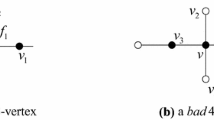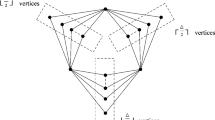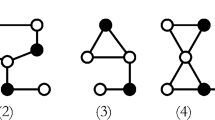Abstract
A vertex coloring is said to be 2-distance if any two distinct vertices of distance at most 2 receive different colors. Let G be a planar graph with girth at least 5. In this paper, we prove that G admits a 2-distance coloring with at most \(\Delta (G)+3\) colors if \(\Delta (G)\ge 339\).









Similar content being viewed by others
References
Bondy JA, Murty USR (1976) Graph theory with applications. Macmillan Ltd. Press, New York
Borodin OV (2013) Colorings of plane graphs: a survey. Discrete Math. 313:517–539
Borodin OV, Ivanova AO (2009) 2-Distance \(\Delta +2\)-coloring of planar graphs with girth six and \(\Delta \ge 18\). Discrete Math. 309:6496–6502
Borodin OV, Ivanova AO (2011a) Injective (\(\Delta +1\))-coloring of planar graphs with girth six. Sibirsk. Mat. Zh. 52:30–38 (in Russian)
Borodin OV, Ivanova AO (2011b) List injective colorings of planar graphs. Discrte Math. 311:154–165
Borodin OV, Broersma H, Glebov H, van den Heuvel J (2002) Stars and bunches in planar graphs. General planar graphs and colourings. Part II. CDAM Researches Report
Borodin OV, Ivanova AO, Neustroeva TK (2004a) 2-Distance coloring of sparse plane graphs. Sib. Èlektron. Mat. Izv. 1:76–90 (in Russian)
Borodin OV, Glebov AN, Ivanova AO, Neustroeva TK, Tashkinov VA (2004b) Sufficient conditions for the 2-distance \(\Delta +1\)-colorability of plane graphs. Sib. Èlektron. Mat. Izv. 1:129–141 (in Russian)
Bu Y, Zhu X (2012) An optimal square coloring of planar graphs. J. Comb. Optim. 24:580–592
Cranston D, Kim S, Yu G (2010) Injective coloring of sparse graphs. Discrete Math. 310:2965–2973
Cranston D, Kim S, Yu G (2011) Injective coloring of graphs with low average degree. Algorithmica 60:553–568
Dong W, Lin W (2013) Injective coloring of planar graphs with girth 6. Discrete Math. 313:1302–1311
Dong W, Lin W (2014) Injective coloring of plane graphs with girth 5. Discrete Math. 315–316:120–127
Dong W, Lin W (2016) An improved bound on 2-distance coloring plane graph with girth 5. J. Comb. Optim. 32:645–655
Dong W, Lin W (2017) On 2-distance coloring of plane graphs with girth 5. Discrete Appl. Math. 217:495–505
Doyon A, Hahn G, Raspaud A (2010) Some bounds on the injective chromatic number of graphs. Discrete Math. 310:585–590
Dvořàk Z, Kràl D, Nejedlỳ P, Škrekovski R (2008) Coloring squares of planar graphs with girth six. Eur J Comb 29:838–849
Hahn G, Kratochvíl J, Širáň J, Sotteau D (2012) On the injective chromatic number of graphs. Discrete Math 256:179–192
Lužar B, S̆krekovski R, Tancer M (2009) Injective colorings of planar graphs with few colors. Discrete Math 309:5636–5649
Molloy M, Salavatipour MR (2005) A bound on the chromatic number of the square of a planar graph. J Comb Theory Ser B 94:189–213
van den Heuvel J, McGuinness S (2003) Coloring of the square of planar graph. J Graph Theory 42:110–124
Wang W, Lih K (2003) Labeling planar graphs with conditions on girth and distance two. SIAM J Discrete Math 17:264–275
Wegner G (1977) Graphs with given diameter and a coloring problem. Technical Report, University of Dortmund, Germany
Acknowledgements
The authors thank the referees for their valuable suggestions which helped to improve the presentation.
Author information
Authors and Affiliations
Corresponding author
Additional information
Supported by Natural Science Foundation of Jiangsu Province of China (No. BK20140089) and NSFC Nos. 11331003 and 11571180.
Appendix: The proofs of the case that v is of type P7 or P8
Appendix: The proofs of the case that v is of type P7 or P8
Suppose that v is of type P7 (i.e., \(d(v)=4\), \(n_2^l(v)=2\) and \(n_2^h(v)=1\)). Let \(N(v)=\{x,y,z,u\}\) in clockwise order with \(d(x)=d(y)=d(z)=2\). By Lemma 2.3(8), \(d(u)\ge \Delta \). Let \(x_1,y_1\) and \(z_1\) be the other neighbor of x, y and z, and let \(f_1,f_2,f_3\) and \(f_4\) be the faces with yvx, zvy, uvz and xvu in their boundaries, respectively. If \(d(f_i)\ge 6\) for some \(1\le i\le 4\), then \(ch(f_i\rightarrow v)\ge \frac{1}{2}\) since \(n_b(f_i)\le d(f_i)-2\). Hence, \(w^*(v)\ge w^\prime (v)+\frac{1}{2}\ge 0\). Otherwise, we suppose that \(d(f_i)=5\) for all \(1\le i\le 4\). Let \(f_1=[yvxx_1y_1]\), \(f_2=[zvyy_1z_1]\), \(f_3=[uvzz_1u_1]\) and \(f_4=[xvuu_2x_1]\).
We have two possibilities.
Case P71 y is the heavy 2-neighbor of v. It follows that \(d(y_1)\ge \Delta -1\). If \(d(x_1)\ge 10\), then \(x_1y_1\) is a heavy edge, and \(ch(x_1\rightarrow f_1)\ge 1\) and \(ch(y_1\rightarrow f_1)\ge \frac{3-\varepsilon }{2}\) by \(R_{21}\), which imply \(ch(f_1\rightarrow v)\ge 1+\frac{3-\varepsilon }{2}\) (as \(n_b(f_1)=1\)), and so \(w^*(v)\ge w'(v)+1+\frac{3-\varepsilon }{2}\ge 0\). Otherwise, we suppose that \(3\le d(x_1), d(z_1)\le 9\) by symmetry. By Lemma 2.2, both \(x_1\) and \(z_1\) have \(p^+\)-neighbors. With the similar reason, we also suppose that \(\max \{d(u_1), d(u_2)\}\le 9\).
Let us calculate \(ch(\{f_1, f_2, f_3, f_4\}\rightarrow v)\).
If \(d(x_1)\ge 5\), then \(w'(x_1)\ge 3d(x_1)-10+3-\varepsilon -(1+\varepsilon )-2(d(x_1)-2)\ge d(x_1)-4-2\varepsilon \) by \(R_{11}\) and \(R_{15}\) (noticing that \(u_2\) is heavy if \(d(u_2)=2\)), which implies \(ch(x_1\rightarrow f_1)\ge \frac{1-2\varepsilon }{5}\). So, \(ch(\{f_1, f_2, f_3, f_4\}\rightarrow v)\ge \frac{1-2\varepsilon }{5}\) (as \(n_b(f_4)=1\)), and \(w^*(v)\ge -2\varepsilon +\frac{1-2\varepsilon }{5}\ge 0\). Suppose so that \(d(x_1)\le 4\).
If \(d(x_1)=3\), then \(d(u_2)\ge 3\) by Lemma 2.3(3), and \(u_2\) is not a 3(1)-vertex with \(n_2^l(u_2)=1\) by Lemma 2.6(1). Now, after the first discharging procedure, \(w'(u_2)\ge -1+3-\varepsilon -(1+\varepsilon )-\varepsilon \ge 1-3\varepsilon \) if \(d(u_2)=3\) (by \(R_{11}\)-\(R_{13}\) and \(R_{15}\)), \(w'(u_2)\ge 3d(u_2)-10+3-\varepsilon -2(d(u_2)-2)-\varepsilon \ge d(u_2)-3-2\varepsilon \) (by \(R_{11}\), \(R_{14}\) and \(R_{15}\)) whenever \(d(u_2)\ge 4\). Hence \(ch(u_2\rightarrow f_4)\ge \frac{1-2\varepsilon }{4}\), which implies \(ch(\{f_1, f_2, f_3, f_4\}\rightarrow v)\ge \frac{1-2\varepsilon }{4}\) (since \(n_b(f_4)=1\)), and so \(w^*(v)\ge -2\varepsilon +\frac{1-2\varepsilon }{4}\ge 0\).
Finally, we suppose that \(d(x_1)=4\). By Lemma 2.3(8), \(u_2\) is not a light 2-vertex. Therefore, \(x_1\) is not a 4-vertex with \(n_2^l(x_1)=2\) and \(n_2^h(x_1)=1\) by Lemma 2.6(2), and \(w'(x_1)\ge 2+3-\varepsilon -4-\varepsilon \ge 1-2\varepsilon \) whenever \(n_2^l(x_1)\)=2 (noticing that \(x_1\) transfers at most \(\varepsilon \) to \(u_2\) in this situation) or \(w'(x_1)\ge 2+3-\varepsilon -2-2(1+\varepsilon )\ge 1-3\varepsilon \) whenever \(n_2^l(x_1)\le 1\). It follows that \(ch(x_1\rightarrow f_1)\ge \frac{1-3\varepsilon }{4}\), and \(ch(f_1\rightarrow v)\ge \frac{1-3\varepsilon }{4}\) (\(n_b(f_1)=1\)), and so \(w^*(v)\ge -2\varepsilon +\frac{1-3\varepsilon }{4}\ge 0\).
Case P72 x is the heavy 2-neighbor of v. It follows that \(d(x_1)\ge p\). If \(d(u_2)\ge 10\), then \(u_2x_1\) and \(uu_2\) are both heavy edges, and \(f_4\) receives at least \(2+3-\varepsilon \) by \(R_{21}\), and so \(w^*(v)\ge -2\varepsilon +5-\varepsilon \ge 0\). Otherwise, we have \(d(u_2)\le 9\). It is easy to check that \(w'(u_2)\ge 3d(u_2)-10+2(3-\varepsilon )-2(d(u_2)-2)\ge d(u_2)-2\varepsilon \) since \(u_2\) receives at least \(3-\varepsilon \) from u and \(x_1\), respectively. By \(R_{22}\), \(ch(u_2\rightarrow f_4)\ge \frac{2-2\varepsilon }{2}\). Hence by \(R_{23}\), \(w^*(v)\ge -2\varepsilon +ch( f_4\rightarrow v)\ge -2\varepsilon +\frac{2-2\varepsilon }{2}\ge 0\) since \(n_b(f_4)=1\).
Suppose that v is of type P8 (i.e., v is a 4-vertex with \(n_2^l(v)=3\)). Let \(N(v)=\{x,y,z,u\}\) with x, y, z being light 2-vertices. By Lemma 2.3(8), \(d(u)\ge \Delta \). For convenience, let \(x_1,y_1\) and \(z_1\) be the other neighbor of x, y and z, respectively. By the definition of light 2-vertex, max \(\{d(x_1),d(y_1),d(z_1)\}\le \Delta -2\). For convenience, we assume that \(f_1,f_2,f_3\) and \(f_4\) are the four faces incident with v, bounded by yvx, zvy, uvz and xvu, respectively. If v is incident with at least two \(6^+\)-faces, then by Claim 3.4 and \(R_{23}\), \(w^*(v)\ge -1-\varepsilon +\frac{2}{3}+\frac{1}{2}\ge 0\) or \(w^*(v)\ge -1-\varepsilon +\frac{1}{2}\times 3\ge 0\). So we assume that v is incident with at most one \(6^+\)-face. We have three possibilities.
Case P81 \(d(f_2)\ge 6\). Let \(f_1=[yvxx_1y_1]\), \(f_3=[uvzz_1u_1]\) and \(f_4=[xvuu_2x_1]\) with \(u_1,u_2\in N(u)\). We will calculate \(ch(\{f_1, f_2, f_3, f_4\}\rightarrow v)\). Notice that \(ch(f_2\rightarrow v)\ge \frac{2}{3}\) by Claim 3.4.
If \(d(x_1)\ge 10\), then \(w^\prime (u_2)\ge 3d(u_2)-10+2+3-\varepsilon -2(d(u_2)-2)\ge d(u_2)-1-\varepsilon \) since \(u_2\) receives at least 2 from \(x_1\) and receives \(3-\varepsilon \) from u. By \(R_{22}\), \(ch(u_2\rightarrow f_4)\ge \frac{1-\varepsilon }{2}\) and \(ch(f_4\rightarrow v)\ge \frac{1-\varepsilon }{2}\) since \(n_b(f_4)=1\). Hence, we have \(w^*(v)\ge -1-\varepsilon +\frac{2}{3}+\frac{1-\varepsilon }{2}\ge 0\).
Otherwise, we may assume that \(3\le d(x_1)\le 9\). By Lemma 2.2, \(x_1\) is adjacent to a \(p^+\)-vertex. We claim that \(d(y_1)\le p-1\). ( Otherwise, \(w'(y)\ge -4+2+3-\varepsilon \ge 1-\varepsilon \) by \(R_{11}\) and \(R_{15}\) in the first step. By \(R_{22}\), \(ch(y\rightarrow v)\ge 1-\varepsilon \). Hence, \(w^*(v)\ge -1-\varepsilon +\frac{2}{3}+1-\varepsilon \ge 0\).) If \(d(u_2)\ge 10\), then \(uu_2\) is a heavy edge. By \(R_{21}\), \(ch(u\rightarrow f_4)\ge \frac{3-\varepsilon }{2}\) and \(ch(u_2\rightarrow f_4)\ge 1\). We have \(ch(f_4\rightarrow v)\ge \frac{3-\varepsilon }{4}+\frac{1}{2}\) since \(n_b(f_4)\le 2\). It follows that \(w^*(v)\ge -1-\varepsilon +\frac{2}{3}+\frac{3-\varepsilon }{4}+\frac{1}{2}\ge 0\). Otherwise, we assume that \(2\le d(u_2)\le 9\).
If \(d(u_2)=2\), then by Lemma 2.3(4), \(d(x_1)\ge 4\). If \(d(x_1)=4\), \(w^\prime (x_1)\ge 2+3-\varepsilon -2-2(1+\varepsilon )\ge 1-3\varepsilon \) by Lemma 2.3(8). If \(d(x_1)\ge 5\), then \(w^\prime (x_1)\ge 3d(x_1)-10+3-\varepsilon -(1+\varepsilon )-2(d(x_1)-2)\ge d(x_1)-4-2\varepsilon \) since \(x_1\) receives at least \(3-\varepsilon \) from its \(p^+\)-neighbors and transfers at most \(1+\varepsilon \) to \(u_2\). We have \(ch(x_1\rightarrow \{f_1, f_4\})\ge \frac{1-2\varepsilon }{5}\times 2\). Hence, \(ch(\{f_1, f_4\}\rightarrow v)\ge \frac{1-2\varepsilon }{5}\times 2\) since \(n_b(f_1)=1\) and \(n_b(f_4)=1\). By \(R_{23}\), \(w^*(v)\ge -1-\varepsilon +\frac{2}{3}+\frac{1-2\varepsilon }{5}\times 2\ge 0\).
Finally, we assume that \(d(u_2)\ge 3\). If \(d(x_1)\ge 4\), then \(w^\prime (x_1)\ge 3d(x_1)-10+3-\varepsilon -2(d(x_1)-2)-\varepsilon \ge d(x_1)-3-2\varepsilon \) since \(x_1\) receives at least \(3-\varepsilon \) from its \(p^+\)-neighbors and transfers at most \( \varepsilon \) to \(u_2\). We have \(ch(x_1\rightarrow \{f_1, f_4\})\ge \frac{1-2\varepsilon }{2}\). Hence \(ch(\{f_1, f_4\}\rightarrow v)\ge \frac{1-2\varepsilon }{2}\) since \(n_b(f_1)=1\) and \(n_b(f_4)=1\). \(w^*(v)\ge -1-\varepsilon +\frac{2}{3}+\frac{1-2\varepsilon }{2}\ge 0\). Otherwise, if \(d(x_1)=3\), then \(d(u_2)\ge 5\) by Lemma 2.7. We have \(w^\prime (u_2)\ge 3d(u_2)-10+3-\varepsilon -\varepsilon -2(d(u_2)-2)\ge d(u_2)-3-2\varepsilon \) since \(u_2\) receives at least \(3-\varepsilon \) from u and transfers at most \(\varepsilon \) to \(x_1\). Hence, \(ch(u_2\rightarrow f_4)\ge \frac{2-2\varepsilon }{5}\). It follows that \(w^*(v)\ge -1-\varepsilon +\frac{2}{3}+\frac{2-2\varepsilon }{5}\ge 0\).
Case P82 \(d(f_3)\ge 6\). For convenience, let \(f_1=[yvxx_1y_1]\), \(f_2=[zvyy_1z_1]\) and \(f_4=[x_1xvuu_1]\) be the three 5-faces incident with v. By Claim 3.4 and \(R_{23}\), \(ch(f_3\rightarrow v)\ge \frac{2}{3}\). We consider \(ch(u_2\rightarrow f_4)\) and \(ch(x_1\rightarrow \{f_1, f_4\})\). This case is quite similar to that of Case P81, so we omit it.
Case P83 \(d(f_i)=5\) for all \(1\le i\le 4\). Without loss of generality, let \(f_1=[yvxx_1y_1]\), \(f_2=[zvyy_1z_1]\), \(f_3=[uvzz_1u_1]\) and \(f_4=[xvuu_2x_1]\) with \(u_1,u_2\in N(u)\). If \(d(u_2)\ge 10\), then \(uu_2\) is a heavy edge, \(ch(\{u,u_2\}\rightarrow f_4)\ge 1+\frac{3-\varepsilon }{2}\) and \(ch(f_4\rightarrow v)\ge \frac{1}{2}+\frac{3-\varepsilon }{4}\) since \(n_b(f_4)\le 2\). It follows that \(w^*(v)\ge -1-\varepsilon +\frac{1}{2}+\frac{3-\varepsilon }{4}\ge 0\).
So we may assume that \(2\le d(u_1)\le 9\) and \(2\le d(u_2)\le 9\) by symmetry. In the following, we will calculate the charge transferred from \(x_1,z_1,y_1,u_1,u_2\) to \(f_1,f_2,f_3\) and \(f_4\).
Subcase P831 \(d(x_1)\ge 10\) and \(d(z_1)\ge 10\). If \(d(y_1)\ge 10\), then both \(x_1y_1\) and \(y_1z_1\) are heavy edges. Hence, \(ch(\{x_1,y_1,z_1\}\rightarrow \{f_1, f_2\})\ge 4\). It follows that \(w^*(v)\ge -1-\varepsilon +4\ge 0\) since \(n_b(f_1)=n_b(f_2)=1\). Otherwise, we may assume that \(3\le d(y_1)\le 9\). By Lemma 2.2, \(y_1\) is adjacent to at least one \(p^+\)-vertex. It is easy to calculate that \(w^\prime (u_2)\ge 3d(u_2)-10+2+3-\varepsilon -2(d(u_2)-2)\ge d(u_2)-1-\varepsilon \) by \(R_{11}\) and \(R_{15}\). By \(R_{22}\), \(ch(u_2\rightarrow f_4)\ge \frac{1-\varepsilon }{2}\) and \(ch(f_4\rightarrow v)\ge \frac{1-\varepsilon }{2}\) since \(n_b(f_4)=1\). By symmetry, \(ch(f_3\rightarrow v)\ge \frac{1-\varepsilon }{2}\).
Moreover, by \(R_{11}\) and \(R_{15}\), \(w^\prime (y_1)\ge 3d(y_1)-10+4-2(d(y_1)-2))\ge d(y_1)-2\), which shows that \(ch(y_1\rightarrow \{f_1, f_2\})\ge \frac{2}{3}\). Again, since \(n_b(f_1)=n_b(f_2)=1\), \(ch(\{f_1,f_2\}\rightarrow v)\ge \frac{2}{3}\). Totally, \(ch(\{f_1, f_2, f_3, f_4\}\rightarrow v)\ge \frac{1-\varepsilon }{2}+\frac{1-\varepsilon }{2}+\frac{2}{3}\). It follows that \(w^*(v)\ge -1-\varepsilon +(1-\varepsilon )+\frac{2}{3}\ge 0\).
Subcase P832 \(d(x_1)\ge 10\) and \(d(z_1)\le 9\). Similar to that of above, if \(d(y_1)\ge 10\), then \(x_1y_1\) is a heavy edge. Hence, \(ch(\{x_1,y_1\}\rightarrow f_1)\ge 2\). It follows that \(w^*(v)\ge -1-\varepsilon +2\ge 0\) since \(n_b(f_1)=1\). Otherwise, we may assume that \(3\le d(y_1)\le 9\).
If \(10\le d(x_1)\le p-1\), then \(d(y_1)\ge 4\) and \(y_1\) is adjacent to a \(p^+\)-vertex by Lemma 2.2. It is easy to check that \(w^\prime (y_1)\ge 3d(y_1)-10+2+3-\varepsilon -\varepsilon -2(d(y_1)-3))\ge d(y_1)+1-2\varepsilon \) since \(y_1\) receives 2 from \(x_1\), receives \(3-\varepsilon \) from it \(p^+\)-neighbors and transfers at most \(\varepsilon \) to \(z_1\). By \(R_{22}\), \(ch(y_1\rightarrow f_1)\ge \frac{5-2\varepsilon }{4}\) and \(ch(y_1\rightarrow f_2)\ge \frac{5-2\varepsilon }{4}\). It follows that \(ch(f_1\cup f_2\rightarrow v)\ge \frac{5-2\varepsilon }{4}\times 2\) as \(n_b(f_1)=n_b(f_2)=1\). By \(R_{23}\), \(w^*(v)\ge -1-\varepsilon +\frac{5-2\varepsilon }{2}\ge 0\).
Otherwise, we assume that \(d(x_1)\ge p\). It is easy to calculate that \(w^\prime (u_2)\ge 3d(u_2)-10+3-\varepsilon +3-\varepsilon -2(d(u_2)-2)\ge d(u_2)-2\varepsilon \) since \(u_2\) receives \(3-\varepsilon \) from \(x_1\) and u, respectively. By \(R_{22}\), \(ch(u_2\rightarrow f_4)\ge 1-\varepsilon \) and \(ch(f_4\rightarrow v)\ge {1-\varepsilon }\) since \(n_b(f_4)=1\). On the other hand, \(w^\prime (x)\ge -4+2+3-\varepsilon \ge 1-\varepsilon \). By \(R_{22}\), \(ch(x\rightarrow v)\ge 1-\varepsilon \). Totally, \(w^*(v)\ge -1-\varepsilon +(1-\varepsilon )+(1-\varepsilon )\ge 0\).
Subcase P833 \(d(x_1)\le 9\) and \(d(z_1)\le 9\).
Notice that min\(\{d(x_1),d(y_1),d(z_1)\}\ge 4\) in this situation by Lemma 2.2. First we assume that \(d(y_1)\le p-1\). It is not difficult to check that \(w^\prime (z_1)\ge 3d(z_1)-10+3-\varepsilon -(1+\varepsilon )-\varepsilon -2(d(z_1)-3)\ge d(z_1)-2-3\varepsilon \) (noticing that \(z_1\) receives \(3-\varepsilon \) from its \(p^+\)-neighbors and transfers at most \(1+\varepsilon \), \(\varepsilon \) to \(u_1\) and \(y_1\), respectively). It follows that \(ch(z_1\rightarrow \{f_2, f_3\})\ge \frac{2-3\varepsilon }{4}\times 2\) and \(ch(\{f_2, f_3\}\rightarrow v)\ge \frac{2-3\varepsilon }{4}\times 2\) since \(n_b(f_2)=n_b(f_3)=1\). By symmetry, \(ch(x_1\rightarrow \{f_1, f_4\})\ge \frac{2-3\varepsilon }{4}\times 2\). We have \(w^*(v)\ge -1-\varepsilon +\frac{2-3\varepsilon }{4}\times 4\ge 0\).
Otherwise, we assume that \(d(y_1)\ge p\). Notice that \(w^\prime (y)\ge -4+2+3-\varepsilon \ge 1-\varepsilon \) by \(R_{11}\) and \(R_{15}\). Hence, \(ch(y\rightarrow v)\ge 1-\varepsilon \) by \(R_{22}\).
Besides, we also calculate the charge transferred from \(x_1\) to it incident faces.
If \(d(x_1)\ge 5\), then \(w^\prime (x_1)\ge 3d(x_1)-10+3-\varepsilon -(1+\varepsilon )-2(d(x_1)-2)\ge d(x_1)-4 -\varepsilon \) since \(x_1\) receives \(3-\varepsilon \) from \(y_1\) and transfers at most \(1+\varepsilon \) to \(u_2\). It follows that \(ch(x_1\rightarrow \{f_1, f_4\})\ge \frac{1-\varepsilon }{5}\times 2\), which induces that \(w^*(v)\ge -1-\varepsilon +1-\varepsilon +\frac{1-\varepsilon }{5}\times 2\ge 0\) since \(n_b(f_1)=n_b(f_4)=1\).
If \(d(x_1)=4\), then by Lemma 2.7(2), \(n_2(x_1)\le 2\). Hence, \(w^\prime (x_1)\ge 2+3-\varepsilon -4-\frac{1}{3}\ge \frac{2}{3}-\varepsilon \). It follows that \(ch(x_1\rightarrow \{f_1, f_4\})\ge \frac{2-3\varepsilon }{12}\times 2\), which induces that \(w^*(v)\ge -1-\varepsilon +1-\varepsilon +\frac{2-3\varepsilon }{12}\times 2\ge 0\).
Finally, if \(d(x_1)=3\), then by Lemma 2.7(1), \(d(u_2)\ge 5\). We consider \(u_2\). It is easy to check that \(w^\prime (u_2)\ge 3d(u_2)-10+3-\varepsilon -\varepsilon -2(d(u_2)-2)\ge d(u_2)-3-2\varepsilon \) since \(u_2\) receives \(3-\varepsilon \) from u and transfers at most \(\varepsilon \) to \(x_1\). Hence \(ch(u_2\rightarrow f_4)\ge \frac{2-2\varepsilon }{5}\) and \(ch(f_4\rightarrow v)\ge \frac{2-2\varepsilon }{5} \), which induces that \(w^*(v)\ge -1-\varepsilon +1-\varepsilon +\frac{2-2\varepsilon }{5}\ge 0\).
Rights and permissions
About this article
Cite this article
Dong, W., Xu, B. 2-Distance coloring of planar graphs with girth 5. J Comb Optim 34, 1302–1322 (2017). https://doi.org/10.1007/s10878-017-0148-7
Published:
Issue Date:
DOI: https://doi.org/10.1007/s10878-017-0148-7




